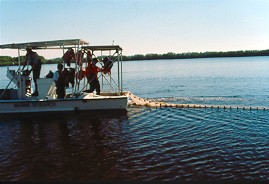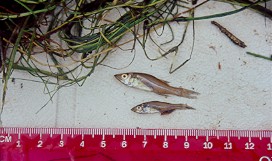 Spatial and temporal patterns of estuarine habitat use by juvenile permit, Trachinotus falcatus in Charlotte Harbor, Florida.
Spatial and temporal patterns of estuarine habitat use by juvenile permit, Trachinotus falcatus in Charlotte Harbor, Florida.

 Spatial and temporal patterns of estuarine habitat use by juvenile permit, Trachinotus falcatus in Charlotte Harbor, Florida.
Spatial and temporal patterns of estuarine habitat use by juvenile permit, Trachinotus falcatus in Charlotte Harbor, Florida.

The life history of many marine fishes is a two-phase cycle: juveniles and adults make up a demersal phase, while larvae are planktonic. For many of these species, the demersal phase is further divided into juvenile and adult stages. Determining habitat use patterns through demersal ontogenetic shifts has important management and habitat conservation implications. The little information on permit, Trachinotus falcatus that exists is based on studies addressing coastal habitats: adults use a variety of coastal marine habitats, while juveniles appear limited to shallow nearshore habitats. In this study we examined ten years of sampling data from the Charlotte Harbor to determine use patterns of juvenile permit in estuarine habitats. 21.3m and 183m seines were used to sample shallow (<1m) habitats in Charlotte Harbor from 1991 through 2000. Size of permit ranged from 15mm to 361mm standard length. Although juveniles were present in all regions of the estuary they were most abundant along shallow shorelines in the lower portion of the estuary. Small juveniles (15 mm - 75mm SL) were most abundant from June to December, and were most abundant on shallow, unvegetated bottom adjacent to unvegetated shorelines. Medium juveniles (100mm - 350mm SL) were also most common in shallow areas, but their abundance did not differ between vegetated or unvegetated bottom or shoreline habitats. The observed habitat shifts by juvenile size approximate diet shifts reported elsewhere. These findings indicate seasonal recruitment of post-settlement fishes to estuarine habitats, followed by ontogenetic habitat shifts before migrating out of the estuary. Future research should seek to determine to what extent juveniles that use estuarine habitats contribute to populations of adults.

 Evaluating The Effects Of Mosquito Ditch Restoration On
Fish Abundance and Performance
Evaluating The Effects Of Mosquito Ditch Restoration On
Fish Abundance and Performance
Freshwater flow in southwest Florida has been radically altered from sheet flow, across hydric flatwoods and coastal tropical hammocks, to channelized flow, in mosquito ditches and water management canals. Alteration in the quality and quantity of freshwater flow potentially has impacted fish populations that utilize oligohaline creeks and upland saltwater ponds as nursery grounds. The Florida Department of Environmental Protection (FL DEP) intends to restore surficial sheet flow to the Charlotte Harbor Buffer Preserve by filling in a network of mosquito ditches and removing dikes. Utilizing a BACI (Before-After-Control-Impacted) experimental design, we propose to monitor the changes in fish community structure and the abundance of tarpon (Megalops atlanticus) and common snook (Centropomus undecimalis) to evaluate the effects habitat restoration. It is predicted that young-of-the-year habitat value will increase while juvenile habitat value will decrease.


